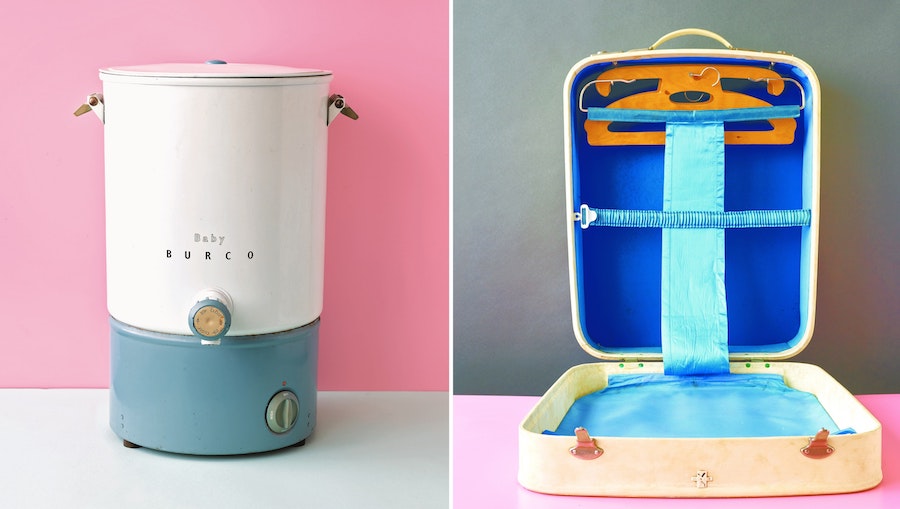From the first Baby Burco to the Rev-Robe suitcase: 8 mid-century items every household had
A new book, Granny’s Kitchen Cupboard, gives a remarkable glimpse into the home-shopping trends of years gone by. Lauren Taylor takes a look.
It might now be the norm to buy something new if a household item breaks, but in the past, homeware was kept and reused for decades. Paper bags from department stores were put away for a rainy day, tins that started out holding lozenges or tobacco continued their useful life storing bolts and screws. Even wrapping paper would often be carefully stored and reused year-on-year.
Nothing quite illustrates this thriftiness, and bygone styles, like the collection of more than 100 objects, discovered at the home of a woman called Jennifer Alexander. Born in the early-1920s, Jennifer served in the Women’s Royal Naval Service during the Second World War and later did stints on a women’s magazine, and after getting married, moved into a house in Surrey in 1960 – the remarkable contents of which only recently came to light, some 50 years on. Now, her son, John Alexander, has turned the haul into a book.
Here are some of the items featured – which you, your parents or even your grandparents, might recognise…
1. The ‘Beehive’ heater

The HMV Cavendish Fan Heater was first manufactured in 1949. From the early-1950s, it was advertised as being conveniently portable and able to warm an entire room through a fan that circulated the warm air. The red-tinted lamp created a warm glow, and the heater itself, made of Bakelite and pressed steel, was available in a range of colour combinations. Because of the D-shaped body with semi-circular front, split into horizontal louvres, it became affectionately nicknamed ‘the Beehive’.
2. Thermos flask

The Thermos flask was invented in 1892, specifically to store chemicals at constant temperatures for experiments, but it wasn’t manufactured for commercial use until later. In 1911, Thermos Limited of England produced the first machine-made glass filler and in 1923, this new large insulated food jar, known as the Thermos Jumbo Jug, was introduced and became instantly popular.
3. Product tins

From the early 19th century, patented medicines and related products were often packaged and sold in tins. Victorian and Edwardian packaging was frequently quite wordy and flowery. Curly banners, serif fonts and overenthusiastic claims of a product’s efficacy all gradually became replaced by greater clarity and integrity. As many of these tins date from the Fifties, Sixties and Seventies, they display the later 20th century’s aim to appear honest, dependable and eye-catching, but not too exuberant or ornate. Many of these brands are still alive and well today.
4. The Rev-Robe suitcase

Before the late 19th century, trunks were heavy, cumbersome and waterproofed for travelling on steamships. By the turn of the 20th century, cases were being made as portable wardrobes. By the 1950s, with the wider availability of consumer air travel, suitcases became lighter and more convenient. The glamour of flying to exotic countries meant luggage design had to follow. Complete with hangers, this solid suitcase, known as the ‘Rev-Robe’ from the Revelation Suitcase Company was first made in 1928, and reflects the style and allure of the jet-set era.
5. Retro toiletries

During the mid to late 20th century, grooming products were fairly minimal. Most households had a styptic pencil; a medicated stick made of powdered alum crystal moulded together with a wax binder. Before the multi-blade razor was invented, styptic pencils sealed small cuts and nicks caused during shaving and so they were an essential part of most men’s shaving kits. During the 1860s, engineer and inventor Mason Pearson joined Raper Pearson and Gill, which made brushes by hand. Pearson invented a mechanical brush-boring machine, and soon after, also designed the innovative rubber-cushion hairbrush that’s still used today.
6. Baby Burco

Used for brewing, sterilising, washing and more, the Baby Burco wash-boiler was produced during the 1950s when the company Burco Dean was formed. It was originally produced for catering, but became popular for domestic use with an advertisement appearing in 1965 that stated: ‘When germs are about… every women knows boiling is the only sure way to kill germs’. It became especially popular among housewives of the Fifties and Sixties for boil-washing terry towelling nappies.
7. Wooden toy puppets

One of the great names of British toy manufacturing, Pelham Puppets was started by ex-serviceman Bob Pelham after World War Two in 1947. It produced simple wooden toys held together with string. Within a few years, Pelham began making marionettes for children as, until then, these were made only for professional use in shows. They were enormously successful and during the company’s lifetime, over 500 different characters were created, from horses to witches, farmers to fairies, and housewives to clowns.
8. Paper shopping bags

In the 1850s, Francis Wolle patented a machine he had created to mass-produce paper bags. Often printed with a store’s logo or brand colours, many have now become collectable. Old paper bags from purchases made at department stores, like Liberty, John Lewis and Selfridges, were often carefully stored and kept for decades afterwards.

Granny’s Kitchen Cupboard: A lifetime In Over 100 Objects by John Alexander, is published by Pavilion Books, priced £14.99. Available now.
The Press Association
Latest posts by The Press Association (see all)
- 5 new books to read this week - November 23, 2024
- 3 easy Mary Berry recipes to make this season - November 22, 2024
- In Pictures: Party stalwart kept New Labour in touch with traditional supporters - November 21, 2024
- 6 easy indoor exercises to try this winter – and why they are good for you - November 19, 2024
- Martin Clunes: I can’t afford to retire – I’ve got too many horses - November 19, 2024





















